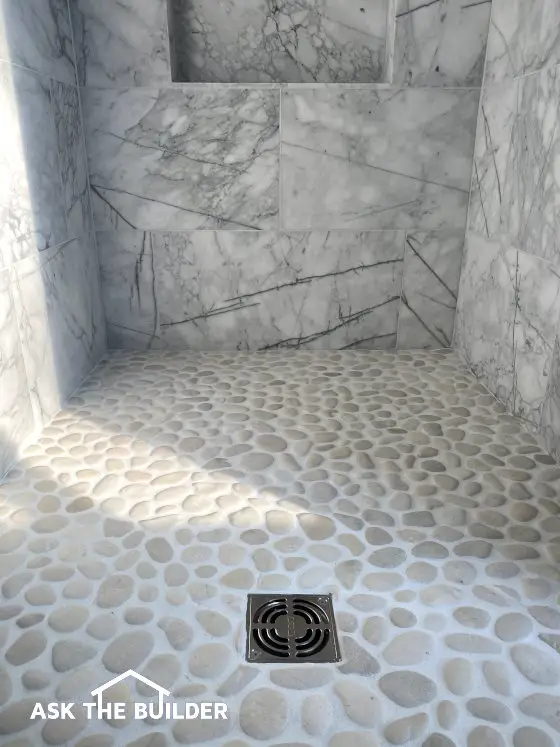Pebble Stone Shower Floor

Pebble Stone Shower Floor | Some people love bumpy shower floors like this because they massage all feet, even smallish ones. Copyright 2020 Tim Carter
Pebble Stone Shower Floor - It's Dreamy and Comfortable
DEAR TIM: What do you think about a pebble stone shower floor? I’ve seen these for a few years and wonder if I’d like it in my new shower? Are they durable? My smallish feet are sensitive when I walk on gravel and I wonder if I’ll be in pain when I’m in the shower. Are these floors hard to install? I’m also worried about all the grout to clean. There seems to be so much grout in these floors! Have you experienced these yourself and what would you do to keep the grout looking like new? Ruth H., Erie, PA
Does the Size of Feet Make a Difference?
Have you ever noticed how some people are so self-conscious about the size of their feet? Feet are such wonderful prizes from Mother Nature when you stop and think about them.
I can relate to Ruth’s issue of sensitivity. I seem to have really sensitive feet because when I walk across gravel, it feels like hundreds of needles sticking me in the feet. It’s important to realize that the gravel I’m talking about is rough and has sharp edges. A pebble stone shower floor produces the exact opposite feeling for me. When I stand on one, it feels like the bottom of my feet are getting a soothing massage.
CLICK or TAP HERE to get FREE BIDS from local tile setters who can install Pebble Floors.
Are Pebble Stone Floors Durable?
Let’s discuss durability. Some of the pebble stone floors are actual pebbles or small rounded stones! My college degree is in geology and most rocks are extremely durable, some can withstand erosion for millions of years. Think of the Grand Canyon!
Tile manufacturers also make faux pebble stone shower floor tile by using the same clay and matte glazes they use to make durable tile. If you choose to use a porcelain pebble stone, you’ll have an extremely durable shower floor that can last for generations.
Are the Pebbles Easy to Install?
The pebble stone floors are not too terribly hard to install. In most cases, the stones come on sheets and the pattern is such that they interlock to create a random look. Cutting the pebbles is done with either a dry or wet-diamond saw. You can make marks with a pencil and use a 4-inch grinder with a dry diamond blade.
This is perhaps the easiest way to make cuts, however, it can be quite dusty. Wear a mask to prevent breathing the dust and use an old fan to blow the dust away from the grinder while cutting. This prevents dust from getting into the moving parts of the grinder’s electric motor.
What is the Best Adhesive?
I’d recommend setting the pebble stone into cement thinset adhesive as opposed to the organic mastics that look like margarine. Be sure to read any installation instructions that might be available from the manufacturer of the pebble stone. They’ll usually suggest the preferred adhesive.
What Grout Should Be Used?
The spaces between the pebbles are so large that you need to use sanded grout. Sanded grout is almost always just a blend of tinted Portland cement and fine silica sand. Silica sand is extremely hard and durable. It’s a very uniform color, often just translucent. The sand makes the grout very strong and it mimics larger stones that we put into concrete for sidewalks, patios, and driveways. The stones give the concrete its strength.
It’s imperative that you use the least amount of water possible when mixing and placing the grout in a pebble stone shower floor. Too much water will cause the grout to shrink and crack as it dries.
Ruth doesn’t have to worry too much about humidity because she lives in the Northeast. If you’re grouting a floor in the West or Southwest USA where humidity can be low, you might need to mist the pebbles and the thinset beneath them to add a bit of moisture so the grouting process is easier. If the humidity is low where you’re installing your floor, cover the floor as soon as you’re done grouting with plastic for 48 hours to slow down the evaporation of the water from the grout. This will help make it very strong.
How Do You Keep the Pebble Shower Floor Clean?
Keeping a pebble stone shower floor clean is somewhat easy, but many people don’t want to invest the time to do it. First and foremost, you need to scrub the floor at least once a week to get rid of body oil, soap and shampoo residue, and plain old dirt. These things are food for mold and mildew.
It’s imperative that the shower floor dries as quickly as possible after you shower. Water fuels mildew and mold growth. If you have a door to the shower, keep it open after you leave the bathroom. The same is true for a shower curtain. Shake off the curtain to remove as much water as possible and keep it retracted so air can get into the shower stall.
You may have to battle hard water stains. This is easy to do with white vinegar. If you see white spots starting to form, you need to get rid of these as soon as possible so you don’t have layer after layer of hard water deposits. White vinegar spritzed onto the tile will do a great job if you let it work for about 30 minutes then scrub and rinse. Yes, there may be a slight odor, but believe me, your pebble stone shower floor will look good for years!
Column 1355